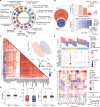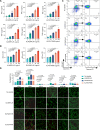Immunopeptidomics-guided discovery and characterization of neoantigens for personalized cancer immunotherapy
- PMID: 40397742
- PMCID: PMC12094241
- DOI: 10.1126/sciadv.adv6445
Immunopeptidomics-guided discovery and characterization of neoantigens for personalized cancer immunotherapy
Abstract
Neoantigens have emerged as ideal targets for personalized cancer immunotherapy. We depict the pan-cancer peptide atlas by comprehensively collecting immunopeptidomics from 531 samples across 14 cancer and 29 normal tissues, and identify 389,165 canonical and 70,270 noncanonical peptides. We reveal that noncanonical peptides exhibit comparable presentation levels as canonical peptides across cancer types. Tumor-specific peptides exhibit significantly distinct biochemical characteristics compared with those observed in normal tissues. We further propose an immunopeptidomic-guided machine learning-based neoantigen screening pipeline (MaNeo) to prioritize neo-peptides as immunotherapy targets. Benchmark analysis reveals MaNeo results in the accurate identification of shared and tumor-specific canonical and noncanonical neo-peptides. Last, we use MaNeo to detect and validate three neo-peptides in cancer cell lines, which can effectively induce increased proliferation of active T cells and T cell responses to kill cancer cells but not damage healthy cells. The pan-cancer peptide atlas and proposed MaNeo pipeline hold great promise for the discovery of canonical and noncanonical neoantigens for cancer immunotherapies.
Figures






References
-
- Camarena M. E., Theunissen P., Ruiz M., Ruiz-Orera J., Calvo-Serra B., Castelo R., Castro C., Sarobe P., Fortes P., Perera-Bel J., Albà M. M., Microproteins encoded by noncanonical ORFs are a major source of tumor-specific antigens in a liver cancer patient meta-cohort. Sci. Adv. 10, eadn3628 (2024). - PMC - PubMed
-
- Chong C., Coukos G., Bassani-Sternberg M., Identification of tumor antigens with immunopeptidomics. Nat. Biotechnol. 40, 175–188 (2022). - PubMed
MeSH terms
Substances
LinkOut - more resources
Full Text Sources
Medical
Molecular Biology Databases

